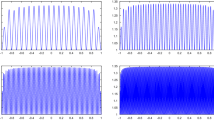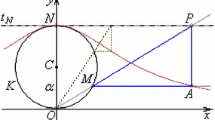Abstract
It is well known that rational interpolation sometimes gives better approximations than polynomial interpolation, especially for large sequences of points, but it is difficult to control the occurrence of poles. In this paper we propose and study a family of barycentric rational interpolants that have no real poles and arbitrarily high approximation orders on any real interval, regardless of the distribution of the points. These interpolants depend linearly on the data and include a construction of Berrut as a special case.
Similar content being viewed by others
References
Baltensperger R., Berrut J.-P., Noël B. (1999). Exponential convergence of a linear rational interpolant between transformed Chebychev points. Math.Comput. 68(227): 1109–1120
Barry P.J., Goldman R.N. (1988). A recursive evaluation algorithm for a class of Catmull-Rom splines. ACM SIGGRAPH Comput. Graph. 22(4): 199–204
Berrut J.-P. (1988). Rational functions for guaranteed and experimentally well-conditioned global interpolation. Comput. Math. Appl. 15(1): 1–16
Berrut, J.-P., Baltensperger, R., Mittelmann, H.D.: Recent developments in barycentric rational interpolation. In: de Bruin, M.G., Mache, D.H., Szabados, J., (eds) Trends and Applications in Constructive Approximation. International Series of Numerical Mathematics, vol. 151, pp 27–51. Birkhäuser, Basel (2005)
Berrut J.-P., Mittelmann H.D. (1997). Lebesgue constant minimizing linear rational interpolation of continuous functions over the interval. Comput. Math. Appl. 33(6): 77–86
Berrut J.-P., Trefethen L.N. (2004). Barycentric Lagrange interpolation. SIAM Rev. 46(3): 501–517
Catmull, E., Rom, R.: A class of local interpolating splines. In: Barnhill R.E., Riesenfeld R.F. (eds) Computer Aided Geometric Design, pp. 317–326. Academic, New York (1974)
Davis P.J., Rabinowitz P. (1984). Methods of numerical integration, 2nd edn. Computer Science and Applied Mathematics. Academic, Orlando
de Boor, C.: A practical guide to splines, revised edn. Applied Mathematical Sciences, vol. 27. Springer, Heidelberg (2001)
Dupuy M. (1948). Le calcul numérique des fonctions par l’interpolation barycentrique. Comptes Rendus de l’Académie des Sciences. Série I, Mathématique 226: 158–159
Franke R. (1982). Scattered data interpolation: test of some methods. Math. Comput. 38(157): 181–200
Franke R., Nielson G. (1980). Smooth interpolation of large sets of scattered data. Int. J. Numer. Methods Eng. 15(11): 1691–1704
Gordon W.J., Wixom J.A. (1978). Shepard’s method of “metric interpolation” to bivariate and multivariate interpolation. Math. Comput. 32(141): 253–264
Higham N.J. (2004). The numerical stability of barycentric Lagrange interpolation. IMA J. Numer. Anal. 24(4): 547–556
Hormann K., Floater M.S. (2006). Mean value coordinates for arbitrary planar polygons. ACM Trans. Graph. 25(4): 1424–1441
Isaacson E., Keller H.B. (1994). Analysis of numerical methods. Dover, New York
Lancaster P., Salkauskas K. (1981). Surfaces generated by moving least squares methods. Math. Comput. 37(155): 141–158
Levin D. (1998). The approximation power of moving least-squares. Math. Comput. 67(224): 1517–1531
Ruprecht, D., Müller, H.: Free form deformation with scattered data interpolation methods. In: Farin G., Hagen H., Noltemeier H., Knödel W. (eds.) Geometric Modelling. Computing Supplementum, vol. 8, pp. 267–281. Springer, Heidelberg (1993)
Schneider C., Werner W. (1986). Some new aspects of rational interpolation. Math. Comput. 47(175): 285–299
Shepard, D.: A two-dimensional interpolation function for irregularly-spaced data. Proceedings of the 23rd ACM national conference, pp. 517–524. ACM Press, (1968)
Taylor W.J. (1945). Method of Lagrangian curvilinear interpolation. J. Res. Nat. Bureau Stand. 35: 151–155
Tee T.W., Trefethen L.N. (2006). A rational spectral collocation method with adaptively transformed Chebyshev grid points. SIAM J. Sci. Comput. 28(5): 1798–1811
Author information
Authors and Affiliations
Corresponding author
Rights and permissions
About this article
Cite this article
Floater, M.S., Hormann, K. Barycentric rational interpolation with no poles and high rates of approximation. Numer. Math. 107, 315–331 (2007). https://doi.org/10.1007/s00211-007-0093-y
Received:
Revised:
Published:
Issue Date:
DOI: https://doi.org/10.1007/s00211-007-0093-y




